| "The appearance of the country around
Wolverhampton and Bilston is strange in the extreme. For miles
and miles the eye ranges over wide-spreading masses of black
rubbish, hills on hills of shale, and mashed and muddled coal
dust, extracted from beneath and masking, as it were, the whole
face of nature."
This description of the area, written in
the middle of the 19th century, paints a vivid picture of an
unpleasant, unhealthy place in which to live and work - the
harsh reality for many of the working classes living in the
industrial areas of England.
Lives were hard and short, and the people
found their entertainment and leisure where they could, more
often than not in the public houses, of which, in Bilston, it is
said that, at the end of the 19th century there was one for
every 140 inhabitants, including children.
The desperate need for public open spaces
to provide those living in the rapidly growing towns with
opportunities for health recreation, was recognised by the early
years of the 19th century but it did not become a reality until
the 1840s when the first public parks were opened in Derby and
Manchester. Birmingham was not far behind, opening their first
park in 1856, but in Wolverhampton, the people had to wait until
the summer of 1881 for the opening of what became known as West
Park.
|
|
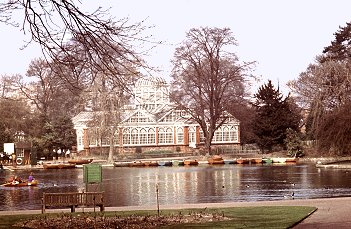
West Park Conservatory built in 1896. |
The council had first set its sights on the town's
race course as the ideal location for a park as early as the
1860s, but it was not until 1879 that terms were agreed with the
Duke of Cleveland who owned the land, when he finally agreed to
a 63 year lease of the site with an option for the council to
buy the land at the end of the term.
From the outset the council was determined that the first
park in the borough should be state of the art. |
| A special sub committee toured the country
looking at the best examples, and advice was sought from the
leading experts in the field. |
|
The eventual design of the park was the
subject of a national competition, won by Richard Hartland
Vertigans, a landscape designer and nurseryman with premises in
Malvern and Edgbaston. His task was not an easy one. To begin
with the site was described at the time as a "treeless swamp" so
a lake would be essential to help drain the land.
The council also specified that the park
should be surrounded by stout railings, and two lodges for park
keepers were to be provided.
|
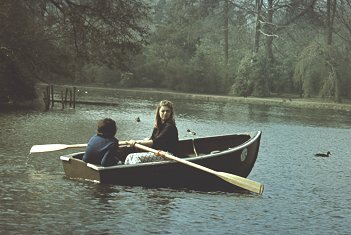
Boating on West Park Lake. |
|
In keeping with the latest trends,
Vertigans made provision for archery, cricket, bowling and
volunteer drill in his design, as well as the planting of trees
and shrubs. Many gifts were made to the park in the early years,
including ducks and swans for the lake, several glacial
boulders, a four faced clock, which still overlooks the flower
beds at the centre of the park, and at least two drinking
fountains. But the most generous gift was that of Charles Pelham
Villiers, MP for Wolverhampton, who was unable to attend the
grand opening of the park, but, instead, gave a beautiful cast
iron bandstand.
|
|
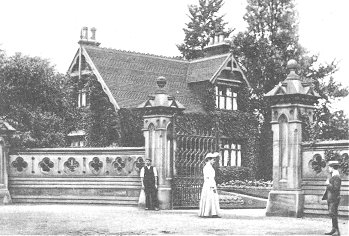
West Park entrance. From an old postcard. |
The park's crowning glory, the
conservatory, was built in 1896, with the proceeds of the town's
Floral Fete, held every year in the park. It was designed by
Thomas Mawson and his architect partner Dan Gibson, who were
advising the council on their second park at the time.
Other improvements in the early years
included new paths around the lakes, the erection of the
lakeside shelter and a tea room called The Chalet, which was
opened in 1902.
|
While the park gradually
evolved over the first 20 years of its existence, Vertigans'
original design of 1897, a plan of which is held in the council
archives, remains virtually unaltered to this day.
The new park soon proved itself a huge
success and a great benefit to the people of the town. However,
its location on the more affluent west side of the town meant
that it was of limited use to those living in the more heavily
industrialised areas to the south and east.
East Park
There was rising political and public
pressure for a comparable park to serve the east end of town and
in 1892 Sir Alfred Hickman and the Duke of Sutherland offered a
gift of 50 acres of land, just off the Willenhall Road, to the
Corporation.
It was, however, a difficult site
consisting largely of collapsed and exhausted mine workings of
the former Chillington Colliery which would require considerable
reclamation in order to create a park.
Once again the council held a competition
for the design, but all the entries far exceeded the budget
allowed for the project.
One design did, however, catch the eye of
the judges - that by Thomas Mawson, who had recently completed
two public parks in the Potteries, and was to become recognised
as one of the outstanding landscape designers of his time.
|
The council decided to use
his basic concept and retained his services to assist the
Borough Surveyor in development of the plans.
Mawson seems to have remained closely
involved with the park and attended site inspections during
works, and the opening ceremony.
The Mayor at this time was Charles Mander,
and Mawson so impressed the family that he was later
commissioned to remodel the gardens at Wightwick Manor.
|
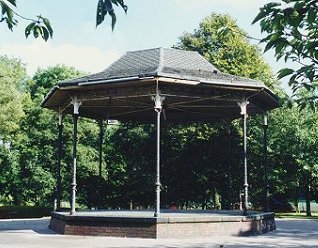
East Park bandstand. |
The final design, a copy of
which is held in the city archives, shows 11 acres of sports
grounds, a children's play area, an open air swimming pool, a
lodge, toilets and areas of shrubberies and flower gardens.
However, the main feature was a 10 acre boating lake with a
promontory on the east shore which was to be the location for an
eyecatcher.
The Lysaght Memorial Clock Tower was
erected on the site in 1887. Although not shown on the borough
surveyor's plan, a bandstand was also erected in the park, paid
for from the proceeds of the annual floral fete. Implementation
of the scheme proved to be both difficult and expensive, and the
budget was soon exceeded, but eventually all was completed and
on September 21, 1896, crowds gathered on a rainy afternoon to
witness the grand opening by the Mayor and Mayoress.
|
|
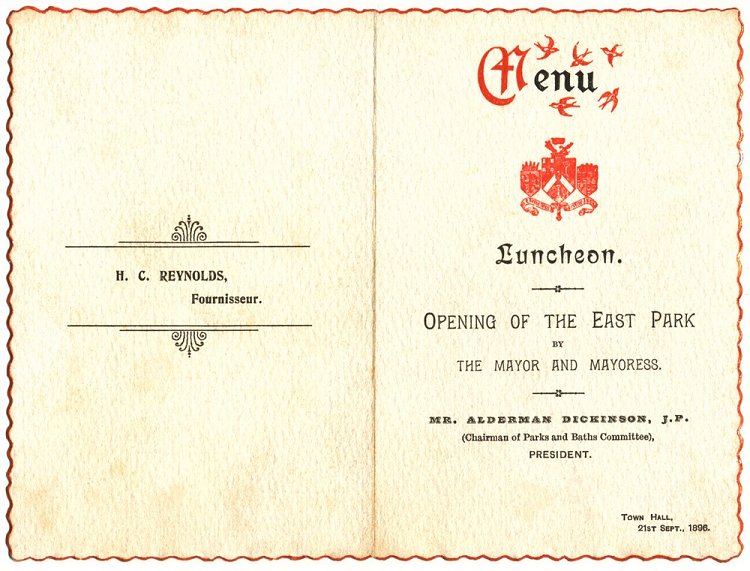
After the opening, the principal
guests were invited to a luncheon at the Town Hall.
Courtesy of David Clare. |
|
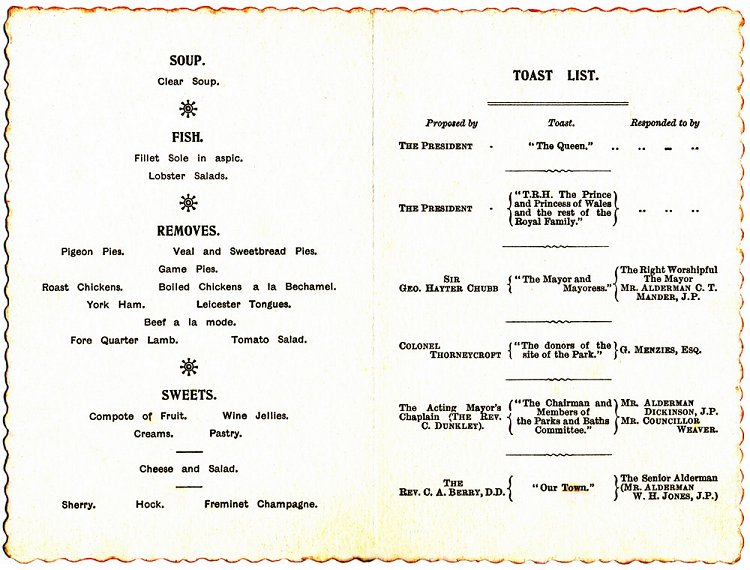
The food and the toasts at the
Town Hall. Courtesy of David Clare. |
|
The East Park, as it became known, was
beset with problems from the outset. The main entrance was 200m
from the Willenhall Road across rough ground, reported to be
ankle deep in dust in the dry weather and deeper in the wet.
Both the Duke of Sutherland and Sir Alfred Hickman had retained
ownership of the surrounding land, no doubt hoping to reap the
benefits of any new developments which would be attracted by the
new park, but this did not materialise and well into the 20th
century the park remained surrounded by open land.
The lake, however, proved to be the biggest
problem. Even during construction there were problems with
leakage into old mine workings and, despite efforts to retain
levels, by pumping water from a specially bored well and
numerous repairs, the lake gradually disappeared. Efforts to
save the lake ceased during the 1914-18 war and by 1922 the area
was reported to be covered with grass. The East Park was never
the huge success its western counterpart had been.
The area surrounding the park was not
developed with housing until the middle years of the 20th
century, and the loss of the lake as an attraction was a major
blow to its popularity, but there was a revival in its fortunes
in the post war period when a paddling pool and new sports
facilities were introduced to serve the new housing which had
grown up around the park.
Hickman Park
After Wolverhampton had celebrated the
opening of its second municipal park a campaign was launched in
neighbouring Bilston to raise funds to open a park, by public
subscription. However, by 1910 only £600 had been raised. It was
then that the family of the late Sir Alfred Hickman offered, as
a memorial, to purchase a site and layout a public park.
The site chosen was that of Springfield
House and grounds, just a mile to the west of the town, plus an
adjoining field which, together comprised 12 acres. The design
was drawn up by the Borough Surveyor. The original drive through
the estate was retained but a new grand entrance was constructed
off Broad Street.
Lawns and paths were laid out and trees and
shrubs planted. At the centre of the park a cast iron canopied
drinking fountain was erected which was paid for by public
subscription to commemorate the Coronation of George V. Opposite
this a timber shelter was erected next to a grotto, complete
with a pool and fountain.
|
|
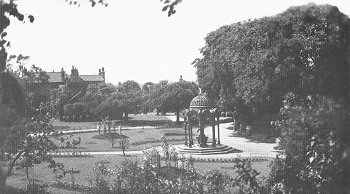
Hickman Park. From an old postcard. |
Lady Hickman made a special gift of a new
and rather unusual bandstand constructed of reinforced concrete.
As with many parks, Hickman Park continued
to evolve over the years. The most significant changes were in
the inter-war years when sports facilities were laid out and an
indoor theatre built with funds raised by Bilston Horticultural
Society.
|
|
Studying the history of our parks we become
aware of how hard ordinary people and politicians battled to
provide public parks at a time when our towns were growing at a
faster rate than ever before and pressure on land was enormous.
Their role in providing opportunities for
recreation and access to green open spaces is just as valid
today as it was a hundred years ago. But today, they must be
valued as part of our heritage, comparable to those examples of
Victorian architecture which provide some of our most treasured
landmarks.
|
 |
Return to
the
previous page |
|